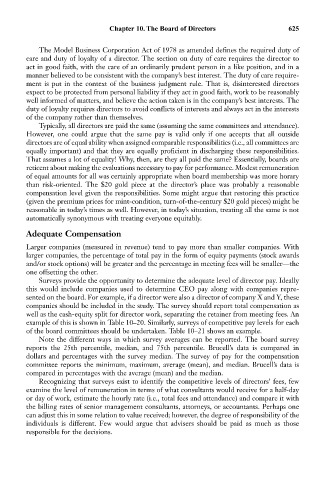Page 640 - Bruce Ellig - The Complete Guide to Executive Compensation (2007)
P. 640
Chapter 10. The Board of Directors 625
The Model Business Corporation Act of 1978 as amended defines the required duty of
care and duty of loyalty of a director. The section on duty of care requires the director to
act in good faith, with the care of an ordinarily prudent person in a like position, and in a
manner believed to be consistent with the company’s best interest. The duty of care require-
ment is put in the context of the business judgment rule. That is, disinterested directors
expect to be protected from personal liability if they act in good faith, work to be reasonably
well informed of matters, and believe the action taken is in the company’s best interests. The
duty of loyalty requires directors to avoid conflicts of interests and always act in the interests
of the company rather than themselves.
Typically, all directors are paid the same (assuming the same committees and attendance).
However, one could argue that the same pay is valid only if one accepts that all outside
directors are of equal ability when assigned comparable responsibilities (i.e., all committees are
equally important) and that they are equally proficient in discharging these responsibilities.
That assumes a lot of equality! Why, then, are they all paid the same? Essentially, boards are
reticent about making the evaluations necessary to pay for performance. Modest remuneration
of equal amounts for all was certainly appropriate when board membership was more horary
than risk-oriented. The $20 gold piece at the director’s place was probably a reasonable
compensation level given the responsibilities. Some might argue that restoring this practice
(given the premium prices for mint-condition, turn-of-the-century $20 gold pieces) might be
reasonable in today’s times as well. However, in today’s situation, treating all the same is not
automatically synonymous with treating everyone equitably.
Adequate Compensation
Larger companies (measured in revenue) tend to pay more than smaller companies. With
larger companies, the percentage of total pay in the form of equity payments (stock awards
and/or stock options) will be greater and the percentage in meeting fees will be smaller—the
one offsetting the other.
Surveys provide the opportunity to determine the adequate level of director pay. Ideally
this would include companies used to determine CEO pay along with companies repre-
sented on the board. For example, if a director were also a director of company X and Y, these
companies should be included in the study. The survey should report total compensation as
well as the cash-equity split for director work, separating the retainer from meeting fees. An
example of this is shown in Table 10–20. Similarly, surveys of competitive pay levels for each
of the board committees should be undertaken. Table 10–21 shows an example.
Note the different ways in which survey averages can be reported. The board survey
reports the 25th percentile, median, and 75th percentile. Brucell’s data is compared in
dollars and percentages with the survey median. The survey of pay for the compensation
committee reports the minimum, maximum, average (mean), and median. Brucell’s data is
compared in percentages with the average (mean) and the median.
Recognizing that surveys exist to identify the competitive levels of directors’ fees, few
examine the level of remuneration in terms of what consultants would receive for a half-day
or day of work, estimate the hourly rate (i.e., total fees and attendance) and compare it with
the billing rates of senior management consultants, attorneys, or accountants. Perhaps one
can adjust this in some relation to value received; however, the degree of responsibility of the
individuals is different. Few would argue that advisers should be paid as much as those
responsible for the decisions.

